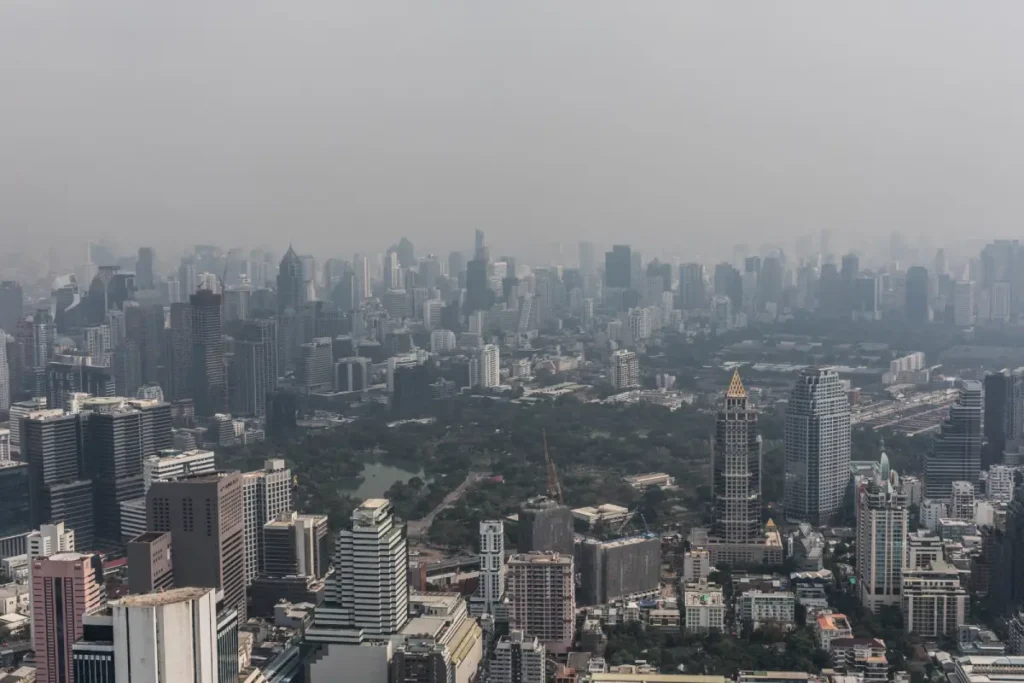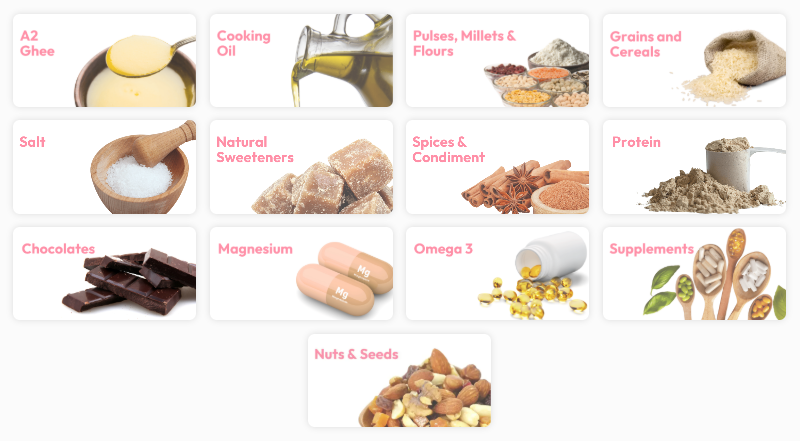Air Pollution & Lung Health: How to Naturally Cleanse and Strengthen Your Lungs

India faces one of the highest pollution levels globally. Cities like Delhi, Gurugram, Lucknow, and Patna often record AQI levels between 350 – 450, over seven times higher than the WHO’s recommended limit of 50. During winter months, smog from stubble burning, vehicle emissions, and industrial output traps PM2.5 and PM10 (PM = Particulate Matter) particles close to the ground, causing a grey haze that fills the air and your lungs.
Every breath you take in such conditions carries microscopic pollutants that reach deep into your respiratory system. Over time, this leads to irritation, inflammation, and gradual deterioration of lung capacity. While there’s a growing trend around “lung detox” products, the truth remains: no instant cleanse exists.
What truly helps is science-backed prevention, smart lifestyle choices, and supporting your lungs’ natural repair system.
Table of Contents
Understanding AQI and Its Impact on Lung Health
What Is AQI?
The Air Quality Index (AQI) quantifies air pollution levels and their potential health impacts. It’s calculated based on six key pollutants: PM2.5, PM10, ozone (O₃), nitrogen dioxide (NO₂), sulfur dioxide (SO₂), and carbon monoxide (CO).

| AQI Range | Air Quality | Health Implications |
| 0–50 | Very Good | Ideal for outdoor activities |
| 51–100 | Good | Acceptable air; minor irritation possible |
| 101–200 | Fair | May affect sensitive individuals |
| 201–300 | Poor | Causes breathing issues for most |
| 301–400 | Very Poor | Respiratory illness with prolonged exposure |
| 401–500+ | Severe | Serious impact even on healthy adults |
Why AQI Matters
A high AQI signals an increase in PM2.5, the most dangerous pollutant – fine particles smaller than 2.5 microns that can penetrate deep into the lungs and bloodstream. Chronic exposure causes oxidative stress, impairs lung tissue, and increases risks of asthma, COPD (Chronic Obstructive Pulmonary Disease) , heart disease, and even stroke.
According to a 2024 Lancet Planetary Health report, poor air quality contributes to over 1.7 million premature deaths annually in India, underscoring the urgent need for personal protection and clean-air initiatives.

The Science Behind Lung Healing
The human lungs have remarkable regenerative abilities. The bronchial cilia – tiny hair-like projections – continuously sweep mucus and trapped pollutants upward so the body can expel them naturally. When pollution exposure reduces, this self-cleaning system quickly rebounds.
Scientific Insights:
~Within 1-9 months of reducing pollutant exposure or quitting smoking, cilia regrow and mucus clearance improves.
~Inflammation markers in the respiratory tract begin to decline, reducing cough and breathlessness.
~Lung elasticity gradually returns, improving oxygen exchange.
~Antioxidant enzymes such as glutathione increase, protecting against oxidative stress.
However, chronic or repeated exposure can cause fibrosis – scarring that limits oxygen diffusion permanently. Hence, early prevention and sustained clean-air habits are vital for preserving long-term lung health.
Evidence-Based Supportive Techniques
1. Steam Inhalation
Steam loosens mucus and improves airway moisture, helping the cilia work more effectively. For added benefit, use tulsi, eucalyptus, or peppermint oil – known to have mild antimicrobial and soothing properties.
Scientific basis: Warm moist air can improve mucociliary clearance and reduce nasal resistance (Journal of Aerosol Medicine, 2019).
2. Breathing Exercises
Breathing practices not only expand lung capacity but also improve oxygen utilization.
~Diaphragmatic breathing: Encourages deep lung expansion.
~Pursed-lip breathing: Helps control shortness of breath.
~Anulom Vilom / Pranayama: Calms the nervous system and enhances oxygenation.
Studies show regular pranayama practitioners have 20–25 % higher vital capacity and reduced inflammatory markers (Indian Journal of Physiology, 2022).
3. Regular Medical Monitoring
For anyone living in polluted cities, an annual lung-function test (spirometry) is recommended.
Spirometry measures two key indicators of respiratory health:
~FEV₁ (Forced Expiratory Volume in One Second): the amount of air you can forcefully exhale in one second – a crucial marker of airway obstruction or restriction.
~FVC (Forced Vital Capacity): the total amount of air you can exhale forcefully after taking a deep breath used to assess lung capacity and elasticity.
A significant reduction in FEV₁ or FVC may indicate early airway narrowing, inflammation, or reduced lung elasticity due to pollution or smoking. Early detection allows timely lifestyle and medical interventions to prevent chronic conditions such as COPD (Chronic Obstructive Pulmonary Disease) or asthma.
Always consult a pulmonologist if you experience:
~Persistent cough beyond three weeks
~Wheezing or shortness of breath
~Chest pain, heaviness, or fatigue on mild exertion

Supporting Natural Lung Cleansing and Repair
Your lungs do not need artificial detox kits – they need support. Here’s how you can strengthen their natural cleaning system:
~Avoid further exposure – monitor AQI, use HEPA-filtered air purifiers, and wear N95/N99 masks outdoors.
~Stay hydrated – drink 2.5-3.5 L/day to thin mucus and aid clearance.
~Exercise regularly – even 30 minutes of brisk walking improves lung ventilation.
~Adopt an anti-inflammatory diet rich in antioxidants, vitamin C, and omega-3s.
~Sleep 7-8 hours – tissue regeneration primarily occurs during deep sleep.
Practical Steps to Reduce Pollution Exposure in Daily Life
Living in India means learning to coexist with fluctuating AQI. Here’s how to minimize damage:
Indoor Protection
~Keep windows closed on high-AQI days; open them during cleaner afternoons.
~Use HEPA 13 air purifiers in bedrooms and living areas.
~Place indoor plants like Areca palm, Peace lily, and Snake plant to absorb VOCs.
~Avoid burning incense sticks or candles regularly – they release ultrafine soot.
~Maintain humidity between 40–60 %; too dry air irritates lungs.
Outdoor Protection
~Check the CPCB AQI app before heading out.
~Avoid outdoor exercise when AQI > 150; shift to indoor workouts.
~Wear certified N95/N99 masks in traffic zones.
~Travel during non-peak hours to avoid high vehicular emission.
Nutrition and Supplements for Lung Health
A balanced diet is central to lung repair. Pollution increases oxidative stress – hence antioxidants and anti-inflammatory nutrients are critical.
| Nutrient | Function | Food |
| Vitamin C | Regenerates antioxidant capacity | Amla, citrus fruits, verified Vitamin C capsules |
| Vitamin E | Improves alveolar elasticity | Nuts, seeds, verified softgels |
| Omega-3 FA | Lowers airway inflammation | Flaxseed, walnuts, fish-oil supplements |
| N-Acetyl Cysteine (NAC) | Breaks down mucus; boosts glutathione | Verified NAC + Vit C formulas |
| Curcumin | Reduces oxidative stress | Turmeric, verified curcumin extract |
Natural Home Remedies to Support Lung Health During Pollution Season
~Tulsi & Honey Elixir: Boil tulsi leaves, cool, add honey. Cleanses and soothes the throat.
~Steam Inhalation: Eucalyptus or peppermint oil steam clears nasal passages.
~Jaggery + Ghee: Helps flush toxins and lubricates lungs.
~Turmeric Milk: Curcumin reduces inflammation from pollution exposure.
~Salt Water Gargle: Removes pollutants and bacteria from the throat.
~Indoor Plants: Areca Palm, Aloe Vera, Peace Lily naturally purify air.
Choose Only the Cleanest – Pink Tiger Verified Products :

Pink Tiger Verified Lung Support: ACE Blend Wonder Latte

Air pollution significantly increases oxidative stress in the lungs, leading to inflammation and reduced respiratory efficiency.The ACE Blend Wonder Latte, a Pink Tiger Verified formulation, combines the power of curcumin, piperine, and MCTs with plant-based antioxidants to help neutralize free radicals, reduce airway inflammation, and support natural respiratory recovery.
Backed by scientific research and verified purity, it’s a clean, effective way to help your lungs breathe easier – especially during high pollution days.
Myths About “Lung Detox” Products
Commercial “lung cleanse” pills, herbal vapors, or detox teas promise instant purification but lack clinical validation. Many contain unstandardized herbs or additives that may harm liver and kidney health.
The Scientific Reality
Lung detox is a physiological process, not a product. The cilia, macrophages, and mucus lining already perform detox functions continuously. Supporting them through clean air, exercise, hydration, and nutrition is far more effective than any marketed supplement.
Clean nutrition and clean air are not luxuries – they’re necessities. By making small, consistent choices toward verified wellness, you empower your lungs to heal, protect, and perform better every single day.
Conclusion
Air pollution is a silent epidemic – invisible yet pervasive. India’s AQI crisis reminds us that the solution isn’t a quick fix but a collective shift toward cleaner living.
Supporting your lungs means adopting a science-driven lifestyle: breathing clean air, eating antioxidant-rich foods, staying hydrated, exercising regularly, and using verified products designed for purity and safety.
Your lungs are remarkably adaptive – when you reduce exposure and nourish them right, they regenerate, strengthen, and defend you better.
So next time you check the AQI, make it a cue to act – wear that mask, turn on your purifier, drink your turmeric-ginger water, and give your lungs the clean air and nutrition they deserve.Because in the end, a lung cleanse isn’t about detox – it’s about daily protection and consistent care.
References (APA 7th Edition)
American Lung Association. (2023). Can you detox your lungs? https://www.lung.org/blog/can-you-detox-your-lungs
Care Insurance. (2024). How to detox your lungs naturally and breathe better. https://www.careinsurance.com/blog/health-insurance-articles/how-to-detox-your-lungs-naturally-and-breathe-better
World Health Organization (WHO). (2023). Air pollution and health. https://www.who.int/news-room/fact-sheets/detail/air-pollution
Central Pollution Control Board (CPCB). (2024). National Air Quality Index data. https://app.cpcbccr.com/AQI_India/
The Lancet Planetary Health. (2023). State of air pollution in India. https://www.thelancet.com/journals/lanplh
FAQ
1.Can I actually detox my lungs after pollution exposure?
Not instantly – but yes, recovery is possible. Your lungs naturally cleanse through the cilia that push out mucus and trapped pollutants. Once exposure reduces, these cilia regrow and resume cleaning. Support them by:
~Avoiding smoke and pollutants
~Staying hydrated
~Eating antioxidant-rich foods (amla, turmeric, green leafy vegetables)
~Practicing deep-breathing exercises
~In 3-6 months of consistent care, most people see better stamina and breathing comfort.
2.How often should I check AQI in India?
Check daily, especially during smog seasons (October–February). AQI levels can change hourly. Use CPCB’s official app or SAFAR for updates. If the AQI crosses 200, limit outdoor exposure and use a purifier indoors.
3.Which foods naturally support lung health?
Include:
Vitamin C-rich foods like citrus, amla, and guava.
Anti-inflammatory spices such as turmeric, ginger, and black pepper.
Cruciferous vegetables (broccoli, cabbage) that activate recovery enzymes.
Healthy fats like ghee, nuts, and seeds to reduce oxidative stress.
Avoid fried, processed, and sugary foods that increase inflammation.
4.Are air purifiers really effective in Indian homes?
Absolutely – but only when verified. HEPA 13 filters trap up to 99.97 % of fine particles, including PM2.5. The best results come from units tested for Clean Air Delivery Rate (CADR) and low ozone emission.
5. What are early signs of lung damage due to pollution?
Persistent dry or productive cough
Wheezing or tightness in chest
Fatigue or shortness of breath on mild exertion
Frequent throat infections or hoarseness
If symptoms persist for more than two weeks, consult a pulmonologist for lung-function testing.